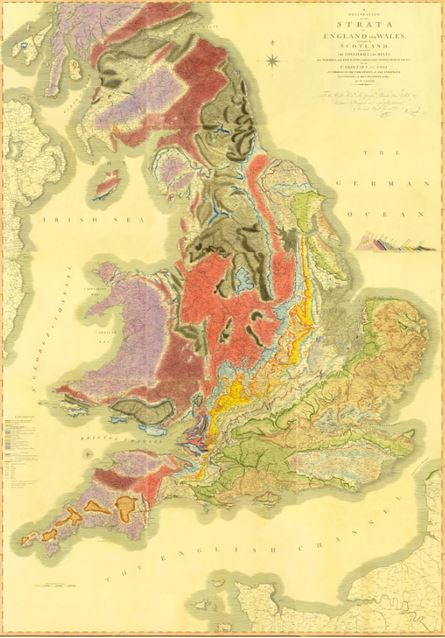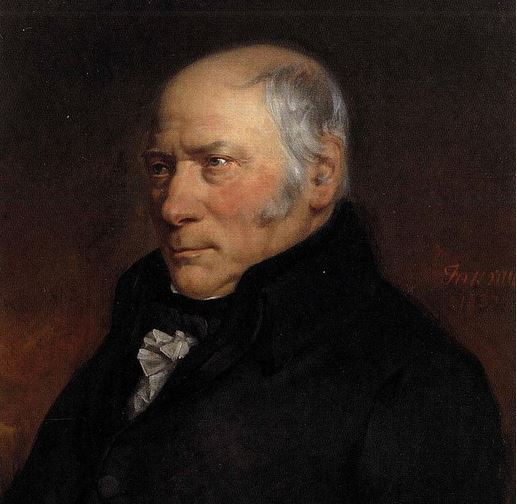The first geological map of a country ever produced and previously thought lost has been uncovered by an archivist at The Geological Society of London. The map, produced by the ‘Father of English Geology’ William Smith (1769-1839), has been digitized and made available online as celebrations begin of its 200th anniversary.
The celebration opens with the unveiling of a plaque at Mr. Smith’s former residence by Sir Richard Attenborough.
The map shows the geological strata of Britain (England, Wales and part of Scotland). The recently-discovered copy is believed to be one of the first ten Mr. Smith produced.

William Smith 1815 map. (Image: The Geological Society)
Geologists say Mr. Smith produced about 370 hand-coloured copies of the map during his lifetime.
As from March 23rd – William Smith’s birthday – you can see the fully restored and digitized images of the new map at the Geological Society’s image library.
The images will also be on display at the Geological Society during several events celebrating the map’s 200th anniversary.
William Smith pioneered the science of stratigraphy and geological mapping. Stratigraphy is a branch of geology concerned with understanding the geometrical relationships between sedimentary rocks.
Smith’s map of England and Wales became the basis for all future geological maps of the UK. He influenced geological surveys across the world.
Chair of the Geological Society’s History of Geology Group, John Henry, said:
“Smith’s importance to the history of our science cannot be overstated. His map is a remarkable piece of work.”
“It helped shape the economic and scientific development of Britain, at a time before geological surveys existed.”
Smith’s recognition was very slow in coming. It was not until February 1831 that the Geological Society conferred on Mr. Smith the first Wollaston Medal in recognition of his achievement.
His achievements became known much more widely after Simon Winchester’s book ‘The Map that Changed the World’ was published in 2001. It tells the story of his relationship with the Geological Society.

William ‘Strata’ Smith (1769–1839), the ‘Father of English Geology’. (Image: Wikimedia)
Mr. Henry said:
“These maps are extremely rare. Each one is a treasure, and to have one of the very first produced is tremendously exciting.”
Experts say it is hard to say how much individual William Smith maps might be worth. An early copy was recently placed on sale at £150,000 ($224,114).
Discovered during an audit
The recently discovered map was found by Victoria Woodcock in 2014, who was then Archive Assistant at the Geological Society, during an audit of its archives led by Caroline Lam, Geological Society Archivist.
Ms. Woodcock said:
“The map was found among completely unrelated material, so at first I didn’t realise the significance of what I’d uncovered.”
“Once we had worked out that it was an early copy of one of the earliest geological maps ever made, I was astonished. It’s the kind of thing that anyone working in archives dreams of, and definitely the highlight of my career so far!”
Experts say the map is a first edition because it has no serial number. They know it is Smith’s work because it has geological features he used in updated later versions.
Mr. Henry said:
“The very first batch of maps Smith produced did not have a series number or signature. Other indications that it is a first edition is the geology depicted on the Isle of Wight, the lack of an engraved line on the Welsh border, and lack of granite around Eskdale in the Lake District.”
According to Geological Society Council minutes from 1815, the map was bought by the Society for the sum of £5 5s (five pounds and five shillings) in that year.
Map in excellent condition
One of the advantages of its disappearance for 200 years is that it has not been exposed to light, so its colours are incredibly well preserved.
Several organizations are getting together to celebrate the bicentennial of William Smith’s map, including the Geological Society, the National Museum Wales, the British Geological Survey, and the Natural History Museum.
Geological Society President, Professor David Manning, said:
“We’re incredibly excited by the discovery. It’s wonderful that the map has been restored and made publicly available in time for the bicentennial celebrations, and we’re very grateful to the sponsors who have made this possible.”
Video – Strata Smith: The Man & The Map
This video was produced by the British Geological Survey.

